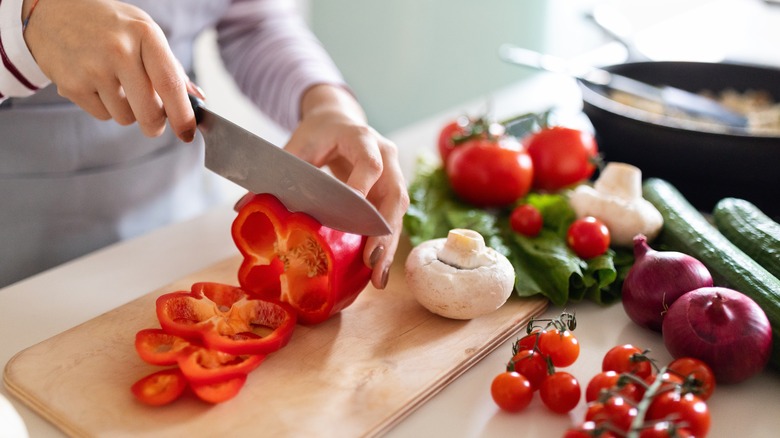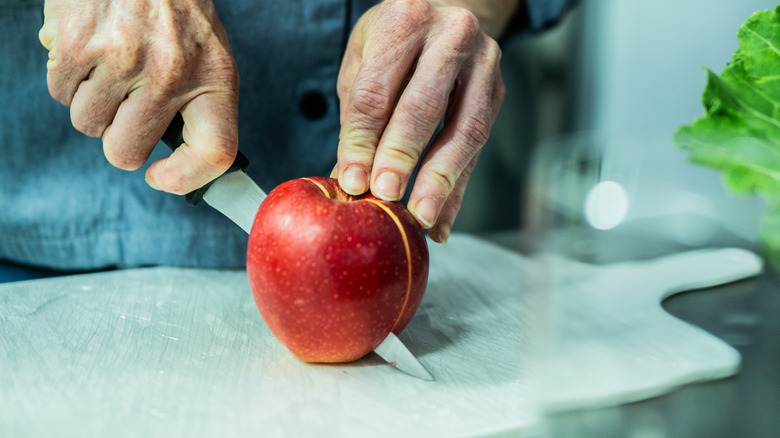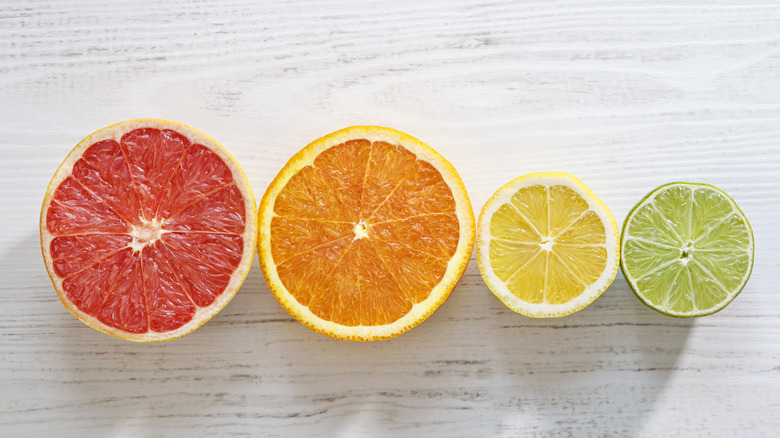Lengthwise Vs Crosswise: What Each Cutting Method Actually Means
Upgrading your knife skills is one of the most important things you can do to be a better cook. From knowing how to hold your kitchen knife to learning basic knife cuts to look like a master chef, it is relatively easy to practice knife skills. But, often, when reading recipes, you will come across instructions to cut an ingredient "lengthwise" or "crosswise." For some, that might be intuitive, learned from observing family elders in the kitchen. But for those who teach themselves to cook, what do those two terms mean?
The easiest way to think of it is to picture a vegetable — let's use a bell pepper for this scenario — and to locate where the stem is. When the stem is away from you, and the pepper is cut from the stem down to its apex, you are cutting along its length, also known as cutting it lengthwise. Some call this cutting "pole to pole" if you were to imagine the vegetable as a planet, cutting from its "north" (stem) to its "south" (apex or opposite end).
As for cutting crosswise, that's across the width of the vegetable. To continue the planet analogy, it would be cutting across the equator or along latitudinal lines. If you were to do this with a bell pepper, it would result in wide rings of pepper. Both methods are useful for different situations. So whether you are cutting vegetables, fruits, or meat, it is worth knowing when to employ which cut.
When to employ lengthwise cuts
With many fruits and vegetables, it is obvious which is the stem end. In the case of produce with stalks like celery and scallions, it is easy to determine its long (read: lengthy) part, often from root to tip. But with some produce, it is not as clear, especially with tubers. Take a potato, for example. Which side of a potato is up? In instances such as those, use actual visual cues to guide you. There are no perfect, mathematically spherical potatoes in the world. There will be an orientation where the potato will appear at least a little long, if not significantly so, like fingerling potatoes. Set that long orientation as its length, and continue as usual.
Using the potato example above, lengthwise cuts are useful to create wedges. Whether for potatoes, pumpkins, or bell peppers, these cuts allow for an eating experience where folks can decide and carve their bite-sized pieces at the table. Fruits are often cut in wedges as well — think of pomes like apples and pears, and drupes like peaches and plums — which are easy to pick up and eat out of hand.
Sometimes, cutting lengthwise helps with particular preparations. Cutting okra lengthwise helps reduce its sliminess, and cutting citrus lengthwise is essential for suprême, a pro cooking technique that anyone can pull off.
When cutting crosswise works better
Many mincing and chopping techniques involve cutting produce crosswise. Think of cutting up chili peppers, carrots, or garlic. Crosswise cuts are how rings or disc shapes are created for cooking, exposing more of the vegetable so it will cook faster. Crosswise cuts are useful for creating specific eating experiences. While bell peppers are often cut lengthwise for stir-fries, cutting them crosswise near the stem end will create a bell pepper cup with its own lid, perfect for a stuffed pepper recipe. Crosswise cuts are also essential for getting the most out of juicing citrus fruits, whether they be large oranges or small limes.
These cutting techniques are not just limited to produce, however. Bread bowls are made by cutting boules crosswise and hollowing out the loaf to create a bowl. Cutting meat against the grain is essentially cutting crosswise — cutting lengthwise (along the grain) could make for a very chewy bite. While the examples listed above are certainly recommended, the kitchen is ultimately your playground. Experiment with lengthwise and crosswise cuts on different food items and see how they influence the texture and taste of the final product!


